



|

|

|
|
JCSref
First time visiting the jcsref website? Check out the welcome page for information.
Browse through the latest news to see what's going on with JCS and level editing in general.
Take a look at this month's feature articles for some of our best content.
Been a while since your last visit? Find out what's new in the latest updates section.
What have people been talking about on the site? Find out in the latest comments section.
Get to know the staff members of jcsref and find out how to contact us.
Our links section is full of great JCS resources. If you can't find it here, you'll find it on one of the links.
|
Topics
Not really sure what you're looking for?
Want to see what all jcsref has to offer?
Check out our topics listing now!
You can use the link above, the book icon up top, or the topics tab to the left.
Search
Do you know exactly what you're looking for?
Are you trying to get information on several topics?
Give our archive search a try!
Use the link above, the magnifying glass icon up top, or the search tab on the left.
Index
Not sure on the spelling of your topic?
Need to browse through some keywords to find what you want?
Our site index is just what you're looking for!
To go there now, use the link above, the papers icon up top, or the index tab to the left.
|
|
|
|
|
|
Viewing node Textured Backgrounds
|

|

|
|
Textured Backgrounds
A lot of levels by new authors do not have the textured backgrounds working. This article will briefly explain how to get a working textured background in your level.
Load up the level you want to add a textured background to. Switch to Layer 8.

Now bring up the Layer Properties window. You can do this either by clicking the layer properties button on the layer toolbar ( ) or by right clicking inside layer 8 and selecting the "Properties..." option: ) or by right clicking inside layer 8 and selecting the "Properties..." option:
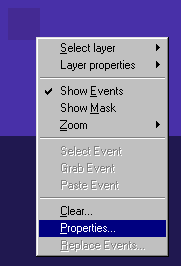
Once inside the layer properties window, check the checkbox marked Texture mode. Some options will now be grayed out while others will become available. Don't worry, that is meant to happen.
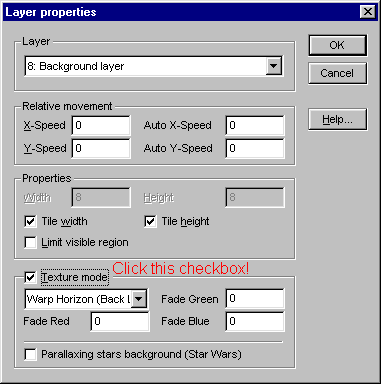
Now, you can configure a little how you want the textured background to look. The following parameters are available for your use:
X-Speed: This sets how fast the textured background will scroll by when you move through the level horizontally, on the left to right axis. If set to 0, it will remain motionless. If set to a negative number, the textured background will scroll by at a negative speed, causing it to move in the same direction that you do. The farther the number you input is from 0, the faster the textured background will move when you move.
Y-Speed: This sets how fast the textured background will scroll by when you move through the level vertically, on the up to down axis. If set to 0, it will remain motionless. If set to a negative number, the textured background will scroll by at a negative speed, causing it to move in the same direction that you do. The farther the number you input is from 0, the faster the textured background will move when you move.
Auto X-Speed: This sets how fast the textured background will scroll by horizontally regardless of whether you are moving or not, thus simulating a "wind" effect. If this value is set to a positive number, the textured background will always move to the left. If a negative number, it will always move to the right. The farther the number you input is from 0, the faster the textured background will move.
Auto Y-Speed: This sets how fast the textured background will scroll by vertically regardless of whether you are moving or not, thus simulating a "wind" effect. If this value is set to a positive number, the textured background will always move upwards. If a negative number, it will always move downwards. The farther the number you input is from 0, the faster the textured background will move.
Tile width: Leave this checked unless you know what you're doing.
Tile height: Leave this checked unless you know what you're doing.
Limit visible region: No effect on textured backgrounds.
The dropdown box with "Warp Horizon (Back Layer)" selected only has one option available, so ignore it.
Fade Red/Green/Blue: In 16-bit color mode, textured backgrounds will always fade away in the distance to a single color. These three values determine what color the textured background will fade away to, by choosing how much of red, green and blue will be in the color. They have minimum values of 0 and maximum values of 255. A few quick examples to get you started:
- 255/255/255: Pure white.
- 0/0/0: Pure black.
- 64/0/128: Bluish purple.
- 160/64/0: Orangish red.
- 0/128/0: Forest green.
Here are some more good examples you can use for your backgrounds. (by Douglas R. Jacobson)
Parallaxing stars background (Star Wars): If you check this box, little stars will appear in the distance of your textured background, useful for nighttime levels.
Exit the layer properties window. You're almost done, now all you have to do is choose the tiles used for the textured background. Most tilesets should have a ready made textured background ready to select and place into layer 8, like so:
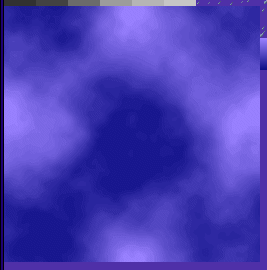
("Marble Garden Day" by Spaztic)
Unfortunately, some tilesets are not quite as simple to use, forcing you to search through them for bits and pieces. Here is a demonstration of this using Beach.
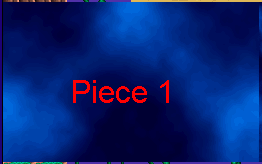     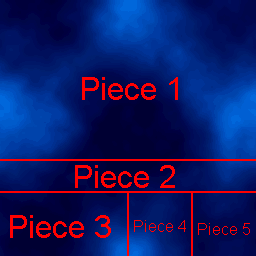
And finally, some tilesets (such as Inferno or Castle) do not have textured backgrounds at all. Always make sure you have the ability to make a textured background before you start doing so.Added on: 2 March 2005 23:09. Made by Violet CLM.
|
|
|

|

